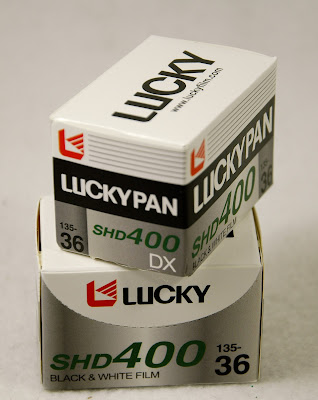LuckyPan SHD 400 what is it, really?
A little over a month ago, I received two rolls from Reflx Lab of “new” LuckyPan SHD 400 to try out. Having memories of shooting that film almost 20 years ago, I was eager to give the new film a try.
The Lucky Film brand goes back to 1958, as China Lucky Film Corp. Based in Baoding, China, Lucky produces a variety of industrial and x-ray films, as well as consumer emulsions. In 2003, Eastman Kodak partnered with Lucky to produce C-41 films and to upgrade the Lucky production facilities, with Kodak backing out of the agreement in 2007. My guess is that Kodak saw how quickly digital was overtaking the industry, and that having more film production elsewhere would hurt their bottom line. Meanwhile, I think Lucky films were available to consumers in China for quite some time afterwards.
My first exposure (ha!) to Lucky films was in 2004, when some of the Lucky films became available in the US market. I don’t recall where I bought the film, but it was probably online, and I have my negatives from 2005, when I first started shooting with it. At the time, the opinion of many photographers was that the Lucky b&w films were second-tier, compared to those from Kodak, Fujifilm, Agfa, and Ilford. Of course, for anyone looking for a bargain, the Lucky films were a bit cheaper, and they offered something a little different. My negatives from 2005 clearly have “LUCKY SHD400 NEW” on the film rebate, as shown below. I wonder of the "new" designation was due to the newer coating machinery that Kodak invested in.
 |
| Lucky SHD400 from 2005 |
The new film via Reflx Lab is labeled on the box as Luckypan SHD 400, with an exp. date of 06/2027. My communication with the representative from Reflx Lab resulted in shooting the film at an ISO of 200, as he didn’t think this is really an ISO 400 film. Some internet sleuthing came up with an ISO recommendation of 160, and that the film is actually an aerial recon film, repackaged as a consumer film. That certainly makes some sense, as there are no edge marking at all on the latest film, as shown below. To me, the film base feels like a PET-based material, rather than triacetate, and looks similar to some Svema surveillance films.
My first test roll of this film was shot at ISO 200 in my Nikon FE, an always-reliable SLR that has produced accurate exposures. I shot the film mostly at Beaver Lake Bird Sanctuary on an overcast, sometimes a bit of rain day, and finished up on a sunny day in Mars Hill, and the last two shots on a cloudy day in Asheville. Developing this film was initially problematic. While there was information inside the box, it did not give a developing time for using D-76, it was the recommended developer. I checked the Massive Development Chart, and it gave a range of 7-10 minutes in straight D-76. I decided on 9 minutes. Standard water stop, and fixing routine, followed by the modified Ilford rinse method (instead of inversions, think cocktail-shaker agitation).
 |
| Loaded into the Nikon FE |
If you go to the Lucky Film website, you will eventually find their information on the films — however, the images for SHD400 show boxes labeled as C-41! Interesting. I did find the development time for the SHD 400, which was 8.5 minutes, so my choice of 9 minutes is pretty close.
Results
I think that rating this film at 200 is certainly appropriate. It’s certainly not the same film emulsion that I used in 2005. It’s grainier than the 2005 film, but not unpleasantly so. These low-key images are quite nice. The price of $5.99/roll for 36 exposures is definitely inexpensive. At this price, you can't go wrong with giving it a try. Shoot it at an ISO of 160 to 200, and I think you'll be happy with the results.














3 comments:
Nice pictures! In fact the one you found on Lucky website is a brand new film being produced by Lucky this year (back in production after a long time!). The one you had (blue base) is probably the repackaged aerial surveillance film, which is different from the one you saw online.
According to my friends, the new version is smoother and great on details without the weird odor. It's not available in U.S. but I think it should be soon!
The one you had is an older version! The ones on their website is actually a newer version being produced this year (back in production after a long time).
John,
That may be so. This was sent to me by Reflx_Lab (in China) to try out.
Thanks,
Mark
Post a Comment